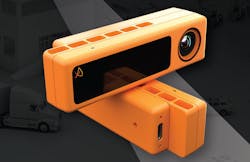Flash LiDAR Delivers Low-Cost, Near-Field 3D Sensing
Check out Electronic Design's coverage of CES 2024. This video is also part of the TechXchange: LiDAR Technology.
What you’ll learn:
- The capabilities of a low-cost, time-of-flight (ToF) flash LiDAR.
- Where is flash LiDAR being used?
- How does artificial intelligence play with ToF sensors?
Time-of-flight (ToF) image sensors provide distance information by using a pulsed light source and then measuring the time for this pulse to reflect back to a sensor. The time is a direct function of the distance to a target. A 3D ToF sensor provides a point cloud with distance information for each point. These are known as flash LiDAR devices.
PreAct’s latest Mojave ToF sensor, which provides this type of support, is able to recognize a person up to 10 m away with a depth accuracy under 2% (see figure). I talked with PreAct’s CEO, Paul Drysch, about ToF, Mojave, and flash LiDAR (see video above). Mojave is just one of the company’s flash LiDAR solutions that targets industrial and consumer applications such as person and gesture recognition. The sensor can be used in robotics applications as well.
ToF sensors have the advantage of providing a point cloud with sufficient information to deliver object and gesture recognition without recording an image. Mojave has a resolution of 320 × 240 at a typical range from 0.3 to 14 m with 94% reflectivity. This goes down to 10% for distances under four meters. It uses a 940-nm infrared LED illuminator that allows for operation in the dark.
The USB-C interface provides connectivity and software includes support for NVIDIA’s Jetson as well as ROS 2. Bindings for C++ and Python are supplied by the SDK, which includes hand and body gesture recognition. Other behaviors that are possible using the sensor include driver monitoring for head movement, texting recognition, and more. Tools and drivers are available for Windows and Linux.
Check out more of Electronic Design's coverage of CES 2024. Also check out more videos/articles in the TechXchange: LiDAR Technology.
About the Author
William G. Wong
Senior Content Director - Electronic Design and Microwaves & RF
I am Editor of Electronic Design focusing on embedded, software, and systems. As Senior Content Director, I also manage Microwaves & RF and I work with a great team of editors to provide engineers, programmers, developers and technical managers with interesting and useful articles and videos on a regular basis. Check out our free newsletters to see the latest content.
You can send press releases for new products for possible coverage on the website. I am also interested in receiving contributed articles for publishing on our website. Use our template and send to me along with a signed release form.
Check out my blog, AltEmbedded on Electronic Design, as well as his latest articles on this site that are listed below.
You can visit my social media via these links:
- AltEmbedded on Electronic Design
- Bill Wong on Facebook
- @AltEmbedded on Twitter
- Bill Wong on LinkedIn
I earned a Bachelor of Electrical Engineering at the Georgia Institute of Technology and a Masters in Computer Science from Rutgers University. I still do a bit of programming using everything from C and C++ to Rust and Ada/SPARK. I do a bit of PHP programming for Drupal websites. I have posted a few Drupal modules.
I still get a hand on software and electronic hardware. Some of this can be found on our Kit Close-Up video series. You can also see me on many of our TechXchange Talk videos. I am interested in a range of projects from robotics to artificial intelligence.

